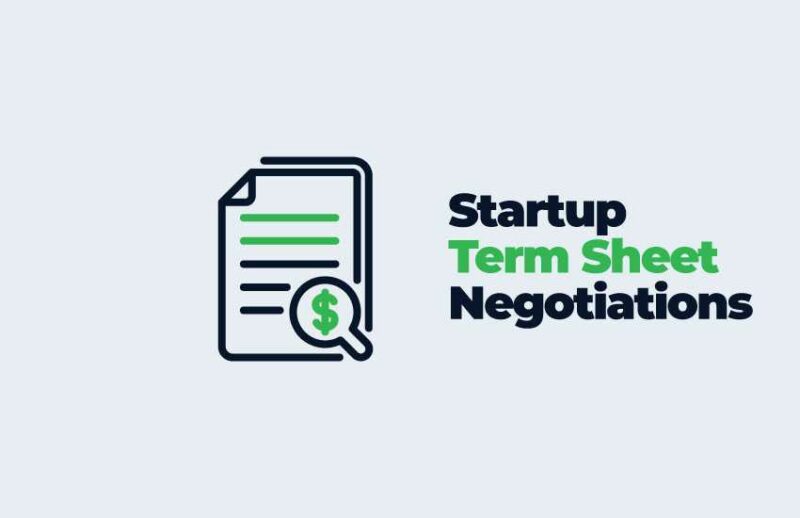Mastering Startup Term Sheet Negotiations

- Securing the Best Deal for Your Startup
- Understanding Term Sheets - Your Guide to Key Components
- Preparing for Negotiations - Research, Prioritize, and Plan
- Initiating Negotiations - Making the First Move
- The Art of Offer and Counteroffer - Navigating the Negotiation Process
- Securing the Best Deal for Your Startup
- Understanding Term Sheets - Your Guide to Key Components
- Preparing for Negotiations - Research, Prioritize, and Plan
- Initiating Negotiations - Making the First Move
- The Art of Offer and Counteroffer - Navigating the Negotiation Process
- FAQs About Term Sheet
Securing the Best Deal for Your Startup
Starting a new company can be an exciting time, but it can also be a challenging one, particularly when it comes to negotiating the perfect term sheet. Whether you’re a seasoned entrepreneur or just starting out, understanding how to negotiate a term sheet is a crucial skill that can make or break your business.
In this guide, we will take a deep dive into the art of negotiating the perfect startup term sheet. We will start by defining what a term sheet is, and then we will walk you through its key components, providing examples of common terms and clauses. Next, we will help you prepare for the negotiation process by sharing our top tips on researching the other party’s interests and negotiating style, as well as determining your own negotiation priorities and limits.
Once you’re ready to start negotiating, we’ll offer advice on how to initiate the negotiation process and guide you through the offer and counteroffer process. We’ll also discuss how to navigate difficult negotiations, with suggestions on how to reach a mutually beneficial outcome.
Finally, we’ll wrap up the guide by discussing how to finalize the term sheet and achieve a mutually beneficial outcome. We’ll provide tips for documenting the final agreement, and we’ll touch on how to address any outstanding issues or concerns. By the end of this guide, you’ll be equipped with all the information you need to negotiate the perfect term sheet for your startup. So, let’s dive in!
Understanding Term Sheets – Your Guide to Key Components
A term sheet is a non-binding document that outlines the key terms and conditions of a potential investment. It sets the foundation for the investment and serves as a roadmap for the legal documents that will follow. Understanding the key components of a term sheet is critical to successfully negotiating the best deal for your startup.
Term sheets can be complex, but they typically include the following components:
- Valuation – This outlines the value of the company and serves as a starting point for the negotiation.
- Investment Amount – This specifies the amount of money the investor is committing to the company.
- Liquidation Preferences – This defines how the proceeds from the sale of the company will be distributed among investors.
- Board Composition – This outlines the composition of the board of directors, including how many seats are allocated to the investors.
- Voting Rights – This specifies the voting rights of investors, including those related to major company decisions.
It’s important to note that these are just some of the key components of a term sheet. Every term sheet is unique and can include additional components or clauses. As a result, it’s important to review each term sheet in detail and ensure that you fully understand its terms and implications.
By understanding the key components of a term sheet, you’ll be better equipped to negotiate favorable terms for your startup. Remember, negotiating a term sheet is just the first step in securing the best deal for your company. Stay tuned for the next section to learn how to prepare for negotiations.
Preparing for Negotiations – Research, Prioritize, and Plan
Before entering into term sheet negotiations, it’s important to do your homework. Researching the other party’s interests and negotiation style, as well as determining your own negotiation priorities and limits, can help set you up for a successful outcome.
Here are some key steps to take when preparing for negotiations:
- Research the Other Party – Research the investor’s background, investment portfolio, and other key factors that may influence their interests and negotiation style. This can help you understand their perspective and identify potential areas of compromise. For example, if the investor has a history of investing in companies in your industry, they may be more willing to negotiate favorable terms with your startup.
- Determine Your Negotiation Priorities – Prioritize what is most important to you in the negotiation, such as valuation, control, or intellectual property rights. It’s important to have a clear understanding of what you are willing to compromise on and what you are not. For example, if retaining control of the company is a top priority, you may be willing to accept a lower valuation in exchange for maintaining a majority stake in the company.
- Set Your Limits – Determine your walk-away point and establish clear limits for what you are willing to concede. This can help you avoid making costly concessions and maintain your negotiating power. For example, if the investor is unwilling to meet your desired valuation, you may decide that it’s better to walk away from the deal than to accept unfavorable terms.
- Develop a Negotiation Plan – Develop a clear and organized plan for the negotiation, including a timeline and key talking points. This can help you stay focused and confident throughout the negotiation process. For example, you may set a goal to reach an agreement on valuation within the first week of negotiations and prepare talking points to address any objections that may arise.
Remember, being well-prepared is key to successful term sheet negotiations. In the next section, we’ll discuss how to initiate the negotiation process and guide you through the offer and counteroffer process.
Initiating Negotiations – Making the First Move
Now that you’ve prepared for negotiations, it’s time to initiate the process. This can be a nerve-wracking step, but it’s important to take the lead in setting the negotiation agenda and timeline.
Here are some key steps to take when initiating negotiations:
- Send a Term Sheet – Start by drafting and sending a term sheet that outlines the key terms and conditions you are seeking. For example, if you’re seeking a $2 million investment at a $10 million pre-money valuation, your term sheet might include those specific figures, as well as other key details such as the desired ownership structure.
- Provide Supporting Documentation – Along with the term sheet, provide supporting documentation such as financial projections, market analysis, and management bios. This can help demonstrate the strength and potential of your startup. For example, you might include a detailed financial model that projects your company’s revenue growth over the next five years and a market analysis that highlights the market opportunity and competitive landscape.
- Set a Timeline – Set a clear and reasonable timeline for the negotiation process, including deadlines for responding to offers and counteroffers. This can help keep negotiations on track and prevent them from dragging on for too long. For example, you might set a deadline of two weeks for the other party to respond to your initial term sheet, and subsequent deadlines for each subsequent round of negotiations.
- Be Responsive – Be responsive to the other party’s requests and inquiries, and maintain an open and transparent line of communication throughout the negotiation process. For example, if the other party requests additional information or clarification on a particular term, respond promptly and provide the information requested.
Remember, the first move in negotiations can set the tone for the entire process. By being clear, organized, and responsive, you can set a positive and productive tone for the rest of the negotiations.
In the next section, we’ll discuss the offer and counteroffer process and provide tips on how to navigate this critical stage of negotiations. Stay tuned to learn how to put your negotiation skills into action.
The Art of Offer and Counteroffer – Navigating the Negotiation Process
Now it’s time to move on to the offer and counteroffer process. This is the heart of negotiation, where both parties make offers, counteroffers, and compromises in order to reach an agreement that satisfies everyone involved.
Here are some key strategies for navigating the offer and counteroffer process:
- Know Your Limits – Before making an offer, be sure to set your negotiation limits. This means determining the highest and lowest price or terms you are willing to accept, as well as your ideal or target outcome. For example, if you’re negotiating a $2 million investment, you might set your highest limit at $2.5 million and your lowest limit at $1.8 million, with an ideal outcome of $2.2 million.
- Make a Reasonable Offer – Your initial offer should be reasonable and justifiable, based on your company’s current valuation, growth potential, and other relevant factors. For example, you might offer a $2.2 million investment at a $10 million pre-money valuation, based on your projected revenue growth and market opportunity.
- Be Prepared to Compromise – Negotiations are all about give and take, so be prepared to compromise on some of your demands in order to reach a mutually beneficial agreement. For example, you might be willing to accept a slightly lower investment amount in exchange for a higher valuation, or vice versa.
- Seek Expert Advice – Consider enlisting the help of an experienced advisor or attorney who can provide valuable guidance and insights throughout the negotiation process. This can help ensure that you are making informed decisions and negotiating from a position of strength.
Remember, negotiations are a two-way street, and both parties should aim to reach a fair and mutually beneficial agreement. By being prepared, reasonable, and flexible, you can increase your chances of securing a deal that meets your company’s needs.
Negotiating a term sheet can be a complex and nuanced process, with many legal and financial considerations to take into account, such as vesting, ESOP, or convertible note. That’s why it’s often a good idea to seek expert advice from an experienced advisor or attorney who can guide you through the negotiation process and help you achieve the best possible outcome.
If you’re looking for expert advice on startup financing, consider reaching out to Easy Capraise financial services. With years of experience in negotiating these terms with VCs and angel investors, our team of advisors can guide you through every step of the negotiation process and help you secure the best deal possible. Contact us right now to learn more.
Securing the Best Deal for Your Startup
Starting a new company can be an exciting time, but it can also be a challenging one, particularly when it comes to negotiating the perfect term sheet. Whether you’re a seasoned entrepreneur or just starting out, understanding how to negotiate a term sheet is a crucial skill that can make or break your business.
In this guide, we will take a deep dive into the art of negotiating the perfect startup term sheet. We will start by defining what a term sheet is, and then we will walk you through its key components, providing examples of common terms and clauses. Next, we will help you prepare for the negotiation process by sharing our top tips on researching the other party’s interests and negotiating style, as well as determining your own negotiation priorities and limits.
Once you’re ready to start negotiating, we’ll offer advice on how to initiate the negotiation process and guide you through the offer and counteroffer process. We’ll also discuss how to navigate difficult negotiations, with suggestions on how to reach a mutually beneficial outcome.
Finally, we’ll wrap up the guide by discussing how to finalize the term sheet and achieve a mutually beneficial outcome. We’ll provide tips for documenting the final agreement, and we’ll touch on how to address any outstanding issues or concerns. By the end of this guide, you’ll be equipped with all the information you need to negotiate the perfect term sheet for your startup. So, let’s dive in!
Understanding Term Sheets – Your Guide to Key Components
A term sheet is a non-binding document that outlines the key terms and conditions of a potential investment. It sets the foundation for the investment and serves as a roadmap for the legal documents that will follow. Understanding the key components of a term sheet is critical to successfully negotiating the best deal for your startup.
Term sheets can be complex, but they typically include the following components:
- Valuation – This outlines the value of the company and serves as a starting point for the negotiation.
- Investment Amount – This specifies the amount of money the investor is committing to the company.
- Liquidation Preferences – This defines how the proceeds from the sale of the company will be distributed among investors.
- Board Composition – This outlines the composition of the board of directors, including how many seats are allocated to the investors.
- Voting Rights – This specifies the voting rights of investors, including those related to major company decisions.
It’s important to note that these are just some of the key components of a term sheet. Every term sheet is unique and can include additional components or clauses. As a result, it’s important to review each term sheet in detail and ensure that you fully understand its terms and implications.
By understanding the key components of a term sheet, you’ll be better equipped to negotiate favorable terms for your startup. Remember, negotiating a term sheet is just the first step in securing the best deal for your company. Stay tuned for the next section to learn how to prepare for negotiations.
Preparing for Negotiations – Research, Prioritize, and Plan
Before entering into term sheet negotiations, it’s important to do your homework. Researching the other party’s interests and negotiation style, as well as determining your own negotiation priorities and limits, can help set you up for a successful outcome.
Here are some key steps to take when preparing for negotiations:
- Research the Other Party – Research the investor’s background, investment portfolio, and other key factors that may influence their interests and negotiation style. This can help you understand their perspective and identify potential areas of compromise. For example, if the investor has a history of investing in companies in your industry, they may be more willing to negotiate favorable terms with your startup.
- Determine Your Negotiation Priorities – Prioritize what is most important to you in the negotiation, such as valuation, control, or intellectual property rights. It’s important to have a clear understanding of what you are willing to compromise on and what you are not. For example, if retaining control of the company is a top priority, you may be willing to accept a lower valuation in exchange for maintaining a majority stake in the company.
- Set Your Limits – Determine your walk-away point and establish clear limits for what you are willing to concede. This can help you avoid making costly concessions and maintain your negotiating power. For example, if the investor is unwilling to meet your desired valuation, you may decide that it’s better to walk away from the deal than to accept unfavorable terms.
- Develop a Negotiation Plan – Develop a clear and organized plan for the negotiation, including a timeline and key talking points. This can help you stay focused and confident throughout the negotiation process. For example, you may set a goal to reach an agreement on valuation within the first week of negotiations and prepare talking points to address any objections that may arise.
Remember, being well-prepared is key to successful term sheet negotiations. In the next section, we’ll discuss how to initiate the negotiation process and guide you through the offer and counteroffer process.
Initiating Negotiations – Making the First Move
Now that you’ve prepared for negotiations, it’s time to initiate the process. This can be a nerve-wracking step, but it’s important to take the lead in setting the negotiation agenda and timeline.
Here are some key steps to take when initiating negotiations:
- Send a Term Sheet – Start by drafting and sending a term sheet that outlines the key terms and conditions you are seeking. For example, if you’re seeking a $2 million investment at a $10 million pre-money valuation, your term sheet might include those specific figures, as well as other key details such as the desired ownership structure.
- Provide Supporting Documentation – Along with the term sheet, provide supporting documentation such as financial projections, market analysis, and management bios. This can help demonstrate the strength and potential of your startup. For example, you might include a detailed financial model that projects your company’s revenue growth over the next five years and a market analysis that highlights the market opportunity and competitive landscape.
- Set a Timeline – Set a clear and reasonable timeline for the negotiation process, including deadlines for responding to offers and counteroffers. This can help keep negotiations on track and prevent them from dragging on for too long. For example, you might set a deadline of two weeks for the other party to respond to your initial term sheet, and subsequent deadlines for each subsequent round of negotiations.
- Be Responsive – Be responsive to the other party’s requests and inquiries, and maintain an open and transparent line of communication throughout the negotiation process. For example, if the other party requests additional information or clarification on a particular term, respond promptly and provide the information requested.
Remember, the first move in negotiations can set the tone for the entire process. By being clear, organized, and responsive, you can set a positive and productive tone for the rest of the negotiations.
In the next section, we’ll discuss the offer and counteroffer process and provide tips on how to navigate this critical stage of negotiations. Stay tuned to learn how to put your negotiation skills into action.
The Art of Offer and Counteroffer – Navigating the Negotiation Process
Now it’s time to move on to the offer and counteroffer process. This is the heart of negotiation, where both parties make offers, counteroffers, and compromises in order to reach an agreement that satisfies everyone involved.
Here are some key strategies for navigating the offer and counteroffer process:
- Know Your Limits – Before making an offer, be sure to set your negotiation limits. This means determining the highest and lowest price or terms you are willing to accept, as well as your ideal or target outcome. For example, if you’re negotiating a $2 million investment, you might set your highest limit at $2.5 million and your lowest limit at $1.8 million, with an ideal outcome of $2.2 million.
- Make a Reasonable Offer – Your initial offer should be reasonable and justifiable, based on your company’s current valuation, growth potential, and other relevant factors. For example, you might offer a $2.2 million investment at a $10 million pre-money valuation, based on your projected revenue growth and market opportunity.
- Be Prepared to Compromise – Negotiations are all about give and take, so be prepared to compromise on some of your demands in order to reach a mutually beneficial agreement. For example, you might be willing to accept a slightly lower investment amount in exchange for a higher valuation, or vice versa.
- Seek Expert Advice – Consider enlisting the help of an experienced advisor or attorney who can provide valuable guidance and insights throughout the negotiation process. This can help ensure that you are making informed decisions and negotiating from a position of strength.
Remember, negotiations are a two-way street, and both parties should aim to reach a fair and mutually beneficial agreement. By being prepared, reasonable, and flexible, you can increase your chances of securing a deal that meets your company’s needs.
Negotiating a term sheet can be a complex and nuanced process, with many legal and financial considerations to take into account, such as vesting, ESOP, or convertible note. That’s why it’s often a good idea to seek expert advice from an experienced advisor or attorney who can guide you through the negotiation process and help you achieve the best possible outcome.
If you’re looking for expert advice on startup financing, consider reaching out to Easy Capraise financial services. With years of experience in negotiating these terms with VCs and angel investors, our team of advisors can guide you through every step of the negotiation process and help you secure the best deal possible. Contact us right now to learn more.
FAQs About Term Sheet
What is a term sheet?
A term sheet is a non-binding document that outlines the key terms and conditions of a potential investment. It sets the foundation for the investment and serves as a roadmap for the legal documents that will follow.
What are the key components of a term sheet?
The key components of a term sheet include valuation, investment amount, liquidation preferences, board composition, and voting rights. However, each term sheet is unique and can include additional components or clauses.
How can I prepare for negotiations?
You can prepare for negotiations by researching the other party’s interests and negotiation style, determining your own negotiation priorities and limits, and developing a negotiation plan.
How do I initiate negotiations?
You can initiate negotiations by drafting and sending a term sheet that outlines the key terms and conditions you are seeking and providing supporting documentation.
What should I do during negotiations?
During negotiations, you should listen carefully to the other party’s concerns and objections, offer counterproposals, and be open to compromise. It’s also important to maintain a positive and professional demeanor and document all agreements in writing.
What should I do after negotiations are completed?
After negotiations are completed, you should finalize the term sheet and achieve a mutually beneficial outcome. This involves documenting the final agreement, addressing any outstanding issues or concerns, and preparing for the next steps in the investment process.
What is a term sheet?
A term sheet is a non-binding document that outlines the key terms and conditions of a potential investment. It sets the foundation for the investment and serves as a roadmap for the legal documents that will follow.
What are the key components of a term sheet?
The key components of a term sheet include valuation, investment amount, liquidation preferences, board composition, and voting rights. However, each term sheet is unique and can include additional components or clauses.
How can I prepare for negotiations?
You can prepare for negotiations by researching the other party’s interests and negotiation style, determining your own negotiation priorities and limits, and developing a negotiation plan.
How do I initiate negotiations?
You can initiate negotiations by drafting and sending a term sheet that outlines the key terms and conditions you are seeking and providing supporting documentation.
What should I do during negotiations?
During negotiations, you should listen carefully to the other party’s concerns and objections, offer counterproposals, and be open to compromise. It’s also important to maintain a positive and professional demeanor and document all agreements in writing.
What should I do after negotiations are completed?
After negotiations are completed, you should finalize the term sheet and achieve a mutually beneficial outcome. This involves documenting the final agreement, addressing any outstanding issues or concerns, and preparing for the next steps in the investment process.
Contact us
Good to have you here! If you have any queries, please leave your message. Our team will reach out soon:)
.




